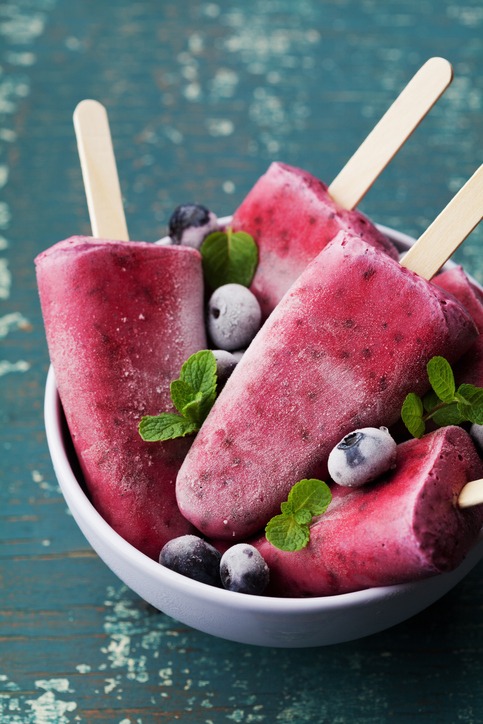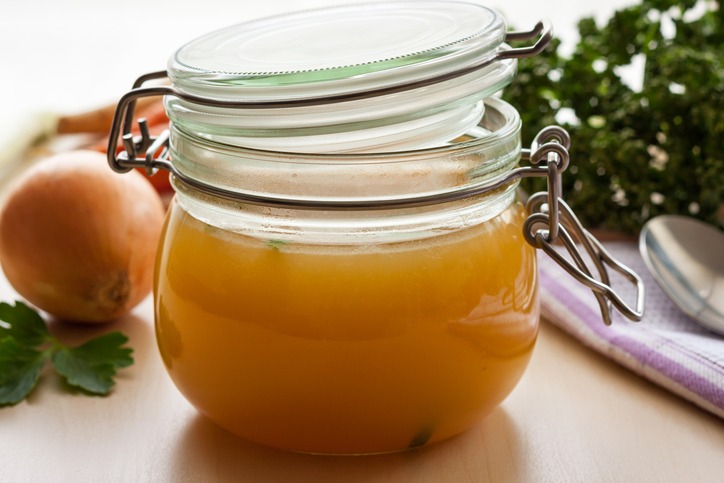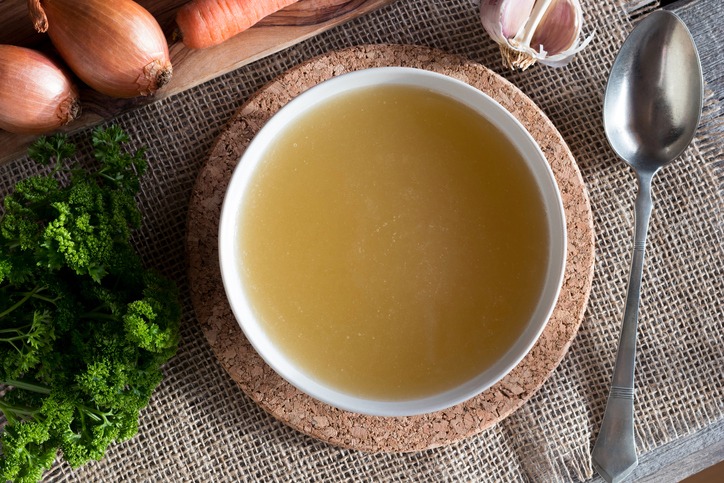Bone Broth is, without doubt, one of the most nourishing foods for our gut.
So if we can include it in our diet so much the better.
However, for vegetarians, bone broth can be a little confronting, (well worth the effort if you can overcome any reservations you may have). An alternative option for vegetarians is Fish Bone Broth – equally if not even more nutritious!
Naturopath Helen Padarin is a great advocate of this healing food and outlines the reasons in her video. This article is based on her video for Mindd Health (below) so you can watch the video below and learn how to make bone broth, with her so simple no fuss recipe.
 I take advantage of any opportunity to add bone broth to a recipe, and these delightful, fruity pops are no exception. Bone broth is highly nutritious and one of the best gut-healing foods, and when straight shots of broth are not welcome by young palates, these treats are ideal.
Makes 8
I take advantage of any opportunity to add bone broth to a recipe, and these delightful, fruity pops are no exception. Bone broth is highly nutritious and one of the best gut-healing foods, and when straight shots of broth are not welcome by young palates, these treats are ideal.
Makes 8
Bone Broth = Food Botox – Collagen for your skin
I like to think of it as Food Botox! There’s lots of collagen in there. It’s excellent, not only for the gut but also for your skin. It’s terrific for preventing premature wrinkles, for example.Great Joint Protection
It’s also great for joints. For anybody who has any history of or tendency to inflammatory joint conditions or degenerative joint conditions, whether it’s osteoarthritis or rheumatoid arthritis, bursitis, things that tend to end up wearing the joint tissue down. It’s also fantastic for athletes, where there is a lot of wear and tear on the joints. Bone broth is a great protective food to include regularly for everyone.Bone Broth is Easy to Make
It’s super easy to make. You can make it with a slow cooker, which I have been doing lately, or you can get a big stock pot and pop it on the stove. The main thing with bone broth is we want to do a slow, long simmer most of the time. Generally speaking, I do a 24-hour simmer, which is why I like using the slow cooker because I feel much more comfortable about leaving it on and forgetting about it.Shorter Cooking Times in Some Cases
There are a few people, however, who will need to do shorter-cooked broths first. If there is some severe gut inflammation going on, or if they’re individuals with glutamate sensitivity, which can manifest in different ways. For kids, it will often manifest behaviorally, where they will be more agitated or have anger outbursts or trouble sleeping, insomnia, difficulty settling down, that kind of thing. That’s because glutamates are the primary excitatory neurotransmitter in the brain. They keep us alert. It’s critical to have them for memory. However, what we need to do is be able to convert glutamate into GABA, which is the brain’s most calming neurotransmitter. We need that to be able to sleep, to be calm and relaxed. If you’re an individual who has problems with that conversion, you can build up an excess of glutamate, and that can make you feel a bit agitated. Again, this is a tiny percentage of the population, and most people do beautifully on slow cooked broth.Putting the Bone Broth Together
This is an excellent way to use up your vegetable scraps. Beautiful, fresh onions are fine, but if you have been cooking and you’ve got onion tops and bottoms because you’ve been using the onions for something else, keep those scraps. We’re talking about the kind of the scraps that you would put in the compost; you can put these into your broth because we’re not going to be eating those veggies. It’s all going to be strained at the end. So, carrot tops, celery leaves, whatever you’ve got. It doesn’t take much work. That’s about as much chopping as you’ll do when you make bone broth. Again, all this is so easy. So literally, just one or two onions, it doesn’t take much. I like to add some peppercorns and bay leaves too.Then add your bones. So, a couple of kilos of bones. These should be beautiful marrow bones from grass-fed cows, but you can use chicken bones as well.Chicken Wings and Feet Make Good Broth Too
If you’re making a chicken broth, what you want to do is use the wings and the feet. It can look a bit crazy, having a pot of feet bubbling away, but that’s where the most gelatin is in the bird. The feet or the bones are fantastic, or necks are great as well. You want the real knuckley, jointy, cartilagey parts of the animal.Using the Whole Animal
“One of the other kind of ethical reasons, I guess that I love both broths, is because I think these days, we know that animals provide an incredible wealth of nutrition for us, and so I think, needing to be grateful for the fact that we’ve got that, but I think we’re also in a society where we have a lot of waste, and if something’s not deemed good enough, then it’s not used. Things like organ meats, which are also amazing nutritionally for us, and bones often get discarded, and I think this is a real waste of an animal that’s been sacrificed for our benefit. I think bone broth is a way of really making sure that we’re honoring that whole animal. We’re not saying part of it’s not worth it, and we also benefit from far more nutrition. We get much more nutrition from the cheaper cuts of meat than the prime cuts of steak.”Top Up Your Pot with Filtered Water and Some Vinegar
Then add filtered water, put the lid on and turn it on. If you are using a slow cooker, set to low for up to 24 hours. As I said unless there’s that glutamate sensitivity present, then you might start out with just a half-an-hour broth, with smaller quantities as well, and then gradually build up the amount and the length of time that you’re cooking it. You can also add a bit of vinegar to the water. You can make it with or without vinegar. Again, people with glutamate issues may have more trouble if it’s been made with vinegar. So if there are glutamate problems, no vinegar. Otherwise, just a splash, a quarter of a cup of vinegar (go for Organic Apple Cider Vinegar). It makes the water more acidic, which draws the minerals out of the bones.Minerals Make the Difference
One of the primary reasons we want bone broth, aside from the fantastic collagen in there, is the minerals. It’s an exceptionally mineral-rich dish. The lining of the gut wall, in particular, as well as all of our cells, really need to be provided with adequate minerals to be able to carry out their enzyme functions, and all their metabolic tasks on a daily basis. So, plenty of minerals are needed for tissue repair, maintenance, and function. Opinions vary, but most suggest that it is difficult to extract the minerals from the bones. However, adding plenty of vegetables and vegetable scraps to the broth will give you plenty of minerals (choose organic vegetables – especially the scaps from the preparation of other meals – so they are not wasted!). Once the bone broth is to be eaten, add more organic vegetables to the strained broth and re-heat it, to boost the nutrients still further. Here are some Bone Broth Recipe ideas for you to try:Basic Bone Broth Recipe
This is a basic recipe to use as a guide – presented by Naturopath Helen Padarin. Vegetable scraps and any vegetables you have maybe added to the pot. Watch Helen’s video presentation here: Remember, you will not eat these vegetables, they will be strained out, so there is also no need to be neat with your chopping, use them whole or in large chunks. If you are sensitive to glutamate or new to bone broth, start making it with just ½ hour cooking time, increase the cooking time as liked or tolerated. Eat smaller amounts, ie. ¼ cup at a time. Work up to cooking your bone broth for longer and consuming more of it.Equipment Needed
A slow cooker OR a large stainless-steel stockpot.Ingredients
- 2 kilos marrow bones from grass-fed cows OR organic chicken bones or a mix of both Note: If making chicken bone broth, you need to include the wings and the feet, necks, organs which are usually attached, as well as the carcass as these contain the most gelatin in the bird. This also makes use of the whole bird, minimal waste.
- 2 onions
- 2 carrots
- 4 sticks celery
- Filtered water to cover the bones
- ¼ cup vinegar (Apple Cider Vinegar) do NOT use this if you are sensitive to glutamate
Method
- Add vegetables and veggie scraps to the slow cooker or stockpot.
- Add bones.
- Cover with water, add vinegar if using.
- Turn the slow cooker to low, cook for up to 24hours, checking and topping up with filtered water as needed.
Serves
4-8Uses
Drink as soup, use as a base for other dishes, eg, Lamb StewStoring Bone Broth
At the completion of the cooking time follow these steps to store your bone broth for future use.
- Slightly cool the bone.

- Use a colander or metal spider to remove the bones and vegetables by pouring the broth into a large glass or stainless-steel bowl.
- Use a metal spoon to portion it out, use ice block trays or molds, preferably silicone, smaller glass containers or stainless-steel containers
- Cool in the fridge or on the bench top and then place in the freezer.
- Once the stock has frozen, you can unmould the ice block molds and put the frozen cubes into a glass container and put back into the freezer. You can buy 1 cup glass containers that are ideal for storing the bone broth.
- Remove from the freezer as needed, try to take out the night before use, if you add it frozen into a dish this will alter the overall cooking time.
Add bone broth to:
- casseroles
- Stir fries
- soup
- ice blocks
Shelf life
3-6months IN FREEZERFruit Smoothie Popsicles with Bone Broth
Recipe by Carla Oates – The Beauty Chef I take advantage of any opportunity to add bone broth to a recipe, and these delightful, fruity pops are no exception. Bone broth is highly nutritious and one of the best gut-healing foods, and when straight shots of broth are not welcome by young palates, these treats are ideal.
Makes 8
I take advantage of any opportunity to add bone broth to a recipe, and these delightful, fruity pops are no exception. Bone broth is highly nutritious and one of the best gut-healing foods, and when straight shots of broth are not welcome by young palates, these treats are ideal.
Makes 8
Ingredients
- 250g strawberries, hulled
- 125g raspberries
- 250g peeled pineapple, cut into chunks
- 1 large handful mint leaves
- 1 tablespoon raw honey, or to taste
Method
- Place the strawberries, raspberries, pineapple and mint in a high-speed blender. Blend until smooth.
- Add the chicken broth and blend to combine.
- Add the honey, to desired sweetness, and blend to combine.
- Pour the smoothie mixture into 8 1/3 cup (80ml) popsicle molds. Insert popsicle sticks.
- Place in the freezer for 4 hours or overnight, until completely frozen.
- Run molds under warm water to help release the popsicles.
Bone Broth Pros and Cons
Pros- contains collagen, which is beneficial for gut, skin, joints, arthritis
- anti-inflammatory (may need to check reference)
- athletes, where there is a lot of wear and tear on the joints
- protective for joints
- tastes delicious
- nourishing, comfort food
- Bone broth is high in glutamate; some people may be sensitive to this which can manifest in many ways. It may cause anxiety in sensitive people or children where it may manifest behaviourally, e.g., where there are more agitated and anger outbursts, trouble sleeping, insomnia. Glutamates are the main excitatory neurotransmitter in the brain. They keep us alert, are essential for memory and learning. Glutamate needs to be converted into GABA which is the brain’s most calming neurotransmitter. When that occurs, calm, sleep and relaxation occur.
- If you are sensitive to glutamate cook the bone broth for less time and consume in smaller quantities.
Bone Broth Q and A
Q: Why eat bone broth? A: It’s nutritious and comforting. Q: What is it good for? A: Healing the gut, skin, joints, reducing inflammation Q: Which nutrients do you get from eating bone broth? A:- Glutamine which heals the gut and reduces inflammation in joints such as arthritis.
- Collagen which is needed in forming skin tissue, avoiding wrinkles and for cartilage and joints.
- Minerals which are needed in every cell in the body to carry out their enzyme and metabolic functions. Although the bones are rich in minerals, it is tough to extract them, and so the best source of the minerals you need will come from the vegetables you cook in the broth (don’t forget organic is by far the best).



